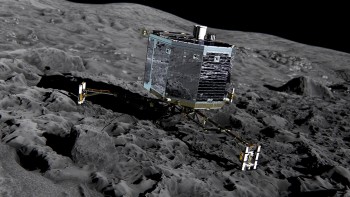On 5 February 2004, ESA announced that the Rosetta mission’s lander would be named “Philae”, the perfect balance to the name “Rosetta”, which of course comes from the famous Rosetta Stone.

Rosetta’s Philae lander
Credits: ESA/ATG medialab
Discovered in Egypt’s Nile delta in 1799 (and which now resides in the British Museum in London, England), the 762 kg Rosetta Stone is carved with inscriptions in ancient Egyptian and Greek, and hieroglyphs.
Philae, meanwhile, is the island in the river Nile on which an obelisk was found that had a bilingual inscription including the names of Cleopatra and Ptolemy in ancient Greek and Egyptian hieroglyphs.
By comparing the inscriptions on the stone and obelisk, historians were able to decipher the mysterious scripts to unlock the secrets of ancient Egyptian civilisation.
Just as the Philae Obelisk and the Rosetta Stone provided this window into the past, so the Philae lander and the Rosetta orbiter aim to unlock the mysteries of the oldest building blocks of our Solar System – comets.
Read the original ESA press release that announced Philae’s name on 5 February 2004: here.









Discussion: no comments